The term "tonsillitis" comes from the Latin name for the tonsils or tonsils. These are special paired rounded almond-shaped formations located on both sides between the palate and the root of the tongue, on the border of the oral cavity and pharynx. Their basis is lymphoid tissue; it is responsible for the maturation of lymphocytes (immunocompetent cells) and the development of an immune response with their help.
The palatine tonsils belong to the peripheral immune organs and, together with other tonsils, form the protective lymphopharyngeal ring of Pirogov-Waldeyer. Their task is to recognize and subsequently destroy pathogens and create an immune barrier at the level of the pharynx. Such protection works both against infectious agents penetrating from outside and against one’s own opportunistic flora.
In most cases, this process is asymptomatic. But sometimes it is not possible to quickly destroy the pathogens; they begin to multiply in the natural recesses (crypts and lacunae) of the tonsils and provoke inflammation. This condition is called tonsillitis.
There are 2 forms of the disease:
- Acute tonsillitis or tonsillitis, the duration of the disease usually does not exceed 10–14 days. The nature of the inflammation can be catarrhal, follicular or lacunar. After the pathogen is destroyed, all symptoms of the disease are leveled, and the tonsils are cleared and return to their previous state.
- Chronic tonsillitis, characterized by prolonged inflammation of the tonsils. The tonsils are enlarged, and a purulent-microbial (caseous) substrate is constantly preserved in their recesses.
Chronic form of tonsillitis, why the tonsils become inflamed
Infection is the main cause of inflammation of the tonsils. The acute form of the disease in 70% of cases is caused by viruses, the remaining 30% is caused by bacterial and fungal flora. Therefore, sore throats most often accompany acute respiratory infections and are seasonal.
Damage to the tonsils in chronic tonsillitis in 80% of cases is of a bacterial nature. The main causative agents of the disease:
- β-hemolytic streptococcus.
- Group A streptococcus.
- Staphylococcus aureus.
- Haemophilus influenzae.
- Rarely encountered bacteria: mycoplasma, chlamydia, etc.
Viruses in the chronic form of the disease have a predominantly provocative, destabilizing effect. Acute and chronic recurrent viral infections weaken the immune defense, which creates conditions for the activation of bacterial flora. Hypothermia, acute intoxication, and ingestion of cold or irritating food lead to the same result.
Endolaryngeal infusions
Recommended for acute laryngitis, along with nebulizers, mucolytics and much more.
The cause of acute laryngitis in most cases is a viral infection. Therefore, the main treatment here is time. The use of antibiotics is not indicated even for mild bacterial infections in the larynx, which are much less common than viral ones.
With endolaryngeal infusion, the solution enters directly onto the vocal folds at the time of phonation, which means there is a very high risk of it entering the lower respiratory tract. In cases where the larynx is poorly visible and the procedure technique is not followed, the doctor pours the solution into the esophagus, the patient swallows it, and there is no positive effect after the procedure, even temporary. At the same time, such a “blind” infusion of the solution increases the risk of aspiration (entry into the respiratory tract).
Antibiotics are used for infusions into the larynx, which, when applied topically, do not have a bactericidal effect. Oil solutions can be used, the positive effect of which is easily replaced by a home humidifier and ventilation. The effect of using hormonal agents (dexamethasone or hydrocortisone) is very short-lived. Moreover, in emergency situations, for example, for singers before a concert, preference should be given to the systemic use of hormonal therapy. The use of hormones leads to the rapid disappearance of inflammation of the vocal folds and improvement of voice quality, but one has to put up with the possible side effects of this group of drugs, so in standard situations the potential risk of their use outweighs the possible benefits.
A number of studies have shown that the voice is restored in equal time - when treated with antibiotics and when taking a placebo.
Important to know : viral laryngitis usually lasts 7-10 days and goes away on its own.
Features of the chronic form of the disease
Chronic inflammation of the tonsils can have several clinical variants:
- Latent form, when the patient does not experience significant discomfort in the throat and does not experience signs of exacerbation of the disease. Such people consider themselves healthy and are not aware of the dormant infectious-inflammatory focus in their throat.
- Periodically relapsing type of disease. Sluggish exacerbations and episodes of clearly defined inflammation of the tonsil itself, adjacent palatine arches and the pharyngeal wall are possible. Between periods of exacerbation, the inflammatory process subsides, but is not completely eliminated.
In chronic tonsillitis, the drainage and natural self-cleaning of crypts (folds) and lacunae (recesses) are disrupted in the tonsils; pus, living and dead bacteria, and toxins are constantly stored in their depths. This maintains constant inflammation, overstimulates sentinel immune cells, and provokes toxic-allergic reactions.
The immune response that forms during chronic tonsillitis is not sufficient to completely suppress the infectious process; it only restrains the activity of pathogens. Disruption of this delicate balance leads to exacerbation of the disease or triggers immune disorders.
Symptoms and signs of purulent sore throat in a child
Purulent tonsillitis in a 2-year-old child can most often develop in two forms, such as lacunar and follicular. Typical signs of lacunar tonsillitis are the formation of pus in the lacunae of the tonsils, as a result of the opening of the follicles, a significant increase in the size of the tonsils due to swelling and the ability to easily remove purulent plaque without any traces. Follicular tonsillitis is also characterized by deep damage to the tonsils, with a transition to the follicles, but located more superficially, significant swelling and the inability to remove purulent plaque, which is also located as if separately, in small plugs, covering the entire surface of the tonsil on both sides. There are also such forms as necrotic and phlegmonous, however, they are rare and are presented in the form of cavities filled with pus.
Purulent tonsillitis in a 3-year-old child and in children of other ages manifests itself 3-5 days after the direct process of infection with a pathogenic microorganism. However, the incubation period can be much shorter, which directly depends on the functioning of the body’s defenses. Often, many parents are concerned about the fact that their child often has a purulent sore throat. This is primarily due to the state of his immune system, its ability to resist the pathogenic effects of bacteria.
Initially, children begin to complain of weakness, become capricious, whiny, refuse to eat, and complain of a sore throat. The temperature of a child with purulent sore throat rises almost simultaneously with the appearance of the above symptoms and this occurs very quickly. Fever can reach levels as high as 39-40°C, accompanied by severe chills and body aches. As a rule, purulent tonsillitis in a 2-year-old child is very difficult to tolerate, with a highly developed intoxication syndrome.
Further, in a fairly short period of time, a dirty white or dirty yellow coating appears in the throat in the area of the tonsils, often with green impurities, and an unpleasant odor. Often, children may completely refuse to eat, it is even difficult for them to drink, it is very painful to speak, and sometimes the pain can radiate to the ear. When examining the oral cavity, there is marked hyperemia of both tonsils, as well as the palatine arches, but without involvement of the posterior wall of the pharynx. In appearance, the tonsils are swollen, enlarged and covered with purulent plaque. In the lacunar form, the plaque is diffuse, merges with each other, but never extends beyond the surface of the tonsils. In the follicular form, only the tonsils are affected by purulent plaque, and the plaque itself is visualized in the form of separate plugs that are not prone to merging. Sometimes one of the tonsils may be affected by the follicular form, and the other lacunar, however, this does not in any way affect the type of treatment prescribed.
Quite often, purulent tonsillitis in a 3-year-old child occurs with enlarged lymph nodes, mainly located in the neck and lower jaw. However, this symptom is not obligatory, as well as laryngeal edema and swelling in the neck area. Often the disease in young children also occurs with somewhat atypical symptoms, such as abdominal pain, diarrhea, and vomiting.
Purulent tonsillitis in children can lead to the formation of quite severe complications in their body, which should never be forgotten. These include kidney damage with the subsequent development of pyelonephritis, stenosing laryngitis, heart damage with the formation of myocarditis, and subsequently rheumatism, and peritonsillar abscesses. Quite rarely, but, however, cases of sepsis in children are recorded.
In medical practice, it is usually customary to distinguish early and late complications of purulent tonsillitis. Early complications arise during the course of the disease and are represented by the spread of the infectious process to nearby tissues, for example, otitis media, peritonsillar abscess. Late complications develop 3 weeks or more after recovery and are represented by pathologies such as arthritis, rheumatic heart disease, and kidney damage. Often, such a reaction of the body in the form of complications is associated with untimely initiation of correct treatment or its absence at all.
Why treat chronic tonsillitis?
Chronically inflamed tonsils become a constant source of infection. With a decrease in immunity, it can spread to other tonsils and peripharyngeal tissue, invade the nasal cavity and paranasal sinuses, and descend into the underlying parts of the respiratory tract.
But the inflammatory reaction of the tonsils is not the main problem of chronic tonsillitis. Constant irritation of the immune forces not only weakens the protective response, but also creates the preconditions for the occurrence of abnormal reactions. Antibodies appear in the body, which are initially produced against β-hemolytic streptococcus, but show aggression towards connective tissue.
This secondary pathology is called rheumatism or Sokolsky-Buyo disease. It is a systemic acquired disease with an autoimmune mechanism, with the favorite targets for antibodies being heart valves and the synovium of small joints.
The key focus of streptococcal infection and the site of primary formation of rheumatic autoantibodies is the inflamed tonsils. Therefore, competent treatment of chronic tonsillitis is an effective prevention of rheumatism and its complications.
Diagnostics
Recognition of acute or chronic forms of the disease is based on the following diagnostic data:
- enlargement and possible soreness of the submandibular and cervical lymph nodes;
- swelling, redness of the tonsils and arches, their inflammatory infiltration;
- discharge of purulent contents when pressing with a spatula on the surface of the tonsils.
To diagnose lesions of other organs, laboratory tests, ECG, radiography of the paranasal sinuses and other studies are used.
How to be treated correctly
Competent treatment of chronic tonsillitis includes a set of measures to eliminate infectious inflammation and deep sanitation (cleansing) of the tonsils. This is necessary to prevent relapses of the disease, suppress allergic and autoimmune processes, and restore the protective function of the pharyngeal lymphadenoid ring.
Common mistakes when treating tonsils:
- Only local medicine for sore throat is used, with the rejection of recommended systemic antibacterial therapy.
- The drug is selected by the patient independently, without taking into account the nature of inflammation, composition and sensitivity of the microflora.
- Drugs for the treatment of chronic tonsillitis are taken haphazardly, or instead of recommended medications, a folk remedy for the disease is used.
- Early cessation of treatment, therapy is completed soon after the sore throat subsides and other symptoms of exacerbation decrease.
- Avoidance of treatment between periods of exacerbation, refusal of proposed surgery.
- Late visit to the doctor, at the stage of complications.
This approach is the main reason for the protracted and complicated course of the disease and the formation of drug resistance in pathogens. Treatment of chronic tonsillitis in adults should be carried out comprehensively, under the supervision of a physician.
How can you gargle for children with sore throat?
To gargle a child's throat with a sore throat, you can use the same solutions as for an adult. The only difference is their concentration.
Gargles are conventionally divided into 2 groups: medicinal and homemade. Solutions that belong to the first group can be purchased at a pharmacy without much difficulty. You can prepare remedies from the second group yourself, based on traditional medicine recipes. The main ingredients will be substances that can be found in any housewife’s house: soda, iodine, salt, strong tea, etc.
To enhance the effect, it is recommended to alternate remedies and gargle with both medical and homemade solutions throughout the day. Let's take a closer look at the different types of gargling medications.
Medicines
To treat sore throat in children, doctors recommend first using medical rinses. These include:
- Hexoral solution - has an antimicrobial effect against bacterial sore throat, approved for use by children from 3 years of age,
- Tantum Verde - characterized by an anti-inflammatory and analgesic effect on the affected area of the throat, is one of the most effective drugs for the treatment of tonsillitis of any form and is approved for children over 6 years of age,
- Furacilin - used as an antiseptic, ideal for the treatment of purulent sore throat (to prepare a solution, a tablet of the drug must be crushed to a powder form and dissolved in 100 g of warm boiled water),
- Miramistin is a strong antibiotic that can quickly relieve inflammation and eliminate infection from the affected area of the throat,
- Chlorophyllipt is an effective remedy for fighting inflammation in purulent sore throat, available in the form of a ready-made solution or tablets that dissolve in the same way as Furacilin,
- Dioxidin is an effective remedy prescribed in cases where other drugs do not help (rinse with the solution three times a day for 5 days).
Solutions based on soda and salt
Solutions prepared with salt and soda are considered a good way to gargle for sore throat in children. They are easy to prepare. You need to take 1/2 teaspoon of each component and dissolve it in 200 ml of hot boiled water. After the solution has cooled to 37-38 degrees, you can give it to your child to gargle with.
The effect of using the product will be better if you add 1-2 drops of iodine to it. The solution should be used immediately after preparation. In this case, for each subsequent rinse you need to prepare a new composition. The number of procedures is about 4-6 per day.
It is worth taking into account that salt in any of the recipes is a component that dries out the mucous membrane of the throat. In order not to worsen the condition of the little patient, it is necessary to maintain a drinking regime (the baby should drink 1 liter of liquid per day)
Folk remedies based on herbal ingredients
In practice, decoctions based on medicinal herbs are often used to gargle in children. Among such plants, chamomile occupies a leading place in eliminating the manifestations of sore throat. To prepare the solution you will need 1 tbsp. dried flowers, brewed in a glass of boiling water. After the liquid has cooled, it needs to be strained. The solution is ready for use. The procedure should be carried out 2-3 times a day.
If your child is allergic to chamomile, you can use calendula, rose hips, elderberry, sage, plantain or eucalyptus instead. The brewing principle is the same.
To prepare the solution, you can also use a mixture of different herbs (chamomile, eucalyptus, calendula). Herbs are taken in equal proportions so that the collection fits into 1 tablespoon. Pour a glass of boiling water over the resulting mixture and leave until the liquid cools. After filtering, the solution is ready for use.
The following recipe uses the same ingredients as the previous one, but replaces the eucalyptus with St. John's wort. The cooking principle is the same.
Treatment without surgery
Conservative treatment includes general and local drug therapy, physiotherapy, lavage of lacunae and other methods of cleansing the tonsils. Antibacterial, anti-inflammatory, antiallergic, and immunomodulatory agents are prescribed.
Conservative therapy is widely used in modern otorhinolaryngology. But it does not always completely cure tonsillitis. The tonsils may remain enlarged even after drug suppression of the infection and deep cleansing; the risk of relapses and complications remains. In approximately 1/3 of patients, it becomes necessary to treat the disease surgically.
Operations for tonsillitis: from traditional methods to modern techniques
Indications for surgical treatment:
- The presence of episodes of exacerbation of the disease 2 or more times a year, with a predominance of purulent inflammation.
- Frequent (more than 4 times a year) exacerbations of tonsillitis, even if they occur without complications.
- Exacerbations are rare, but there are signs of complications from the heart, joints, kidneys or other organs.
- The disease is latent (hidden), but has become the cause of the development of rheumatism and other systemic diseases.
For a long time it was believed that chronically inflamed tonsils should be completely removed. This operation is called tonsillectomy. It allows you to eliminate the source of infection, but makes an uncorrectable hole in the protective lymphoid ring of the pharynx.
Currently, tonsillectomy is rarely performed, mainly in cases of severe purulent-destructive changes in the tonsils. In all other cases, ENT doctors give preference to organ-preserving operations, trying to leave an island of functionally active tonsil tissue.
But resection (partial cutting off of the tonsils) carries the risk of relapse of the disease. After all, such a procedure does not guarantee the elimination of all inflamed and infected tissue. The use of a laser improves the result due to an additional disinfecting and immunomodulating effect in the surgical area, but still does not completely solve the problem of relapses. Nevertheless, laser technologies are recognized as a priority in the treatment of tonsillitis.








